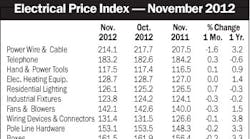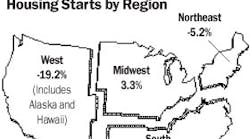Latest from Mag
People - Dec 21, 2012
Obituaries - Dec 21, 2012
November EPI Index Shows No Change
Housing Starts Dip 4% in November
Electrical Marketing - December 21, 2012
Around the Industry - Dec 21, 2012
Economists at McGraw-Hill’s 2008 Construction Forecast were cautiously optimistic that the U.S. economy would not slide into recession in 2008.
None of the speakers at the conference, held Oct. 25 in Washington, D.C., pretended to know exactly how much further the housing market still had to fall or the full impact of the sub-prime loan crisis and enormous housing overhang. However, they said outside of the housing market, the U.S. economy was solid.
“All of the slowdown is in one sector — housing,” said David Wyss, chief economist, Standard & Poors, New York. “I see another year of sluggish growth. I think we will avoid a recession, but there’s not a lot of room for other things to go wrong.”
Wyss also said the rest of the world, led by China and India, was growing faster than the United States, and had “largely ignored the slowdown in the U.S.” Standard & Poors expects international growth to decline slightly in 2008, but that the slower growth in the United States and Europe will be offset by stronger growth in Asia. Wyss expects 2008 real gross-domestic product (GDP) in China and India to grow 11.5 percent and 9 percent, respectively.
Attendees were happy to hear that the price of metal building commodities such as copper and aluminum probably won’t go up in 2008. John Mothersole, principal, industry practices for Global Insight, Waltham, Mass., tracks building material pricing closer than any other economist in the United States. He doesn’t expect metal products to get any worse. “Materials price escalation looks to continue slowing, at least for a few quarters,” he says. Mothersole called copper “the bane of my existence” because of the difficulty in forecasting global supply-and-demand trends in the copper market, particularly Chinese consumption. He also said while aluminum prices will continue to decline, prices for magnesium and silicon metal, the materials used to produce aluminum alloys, “are going through the roof.”
Robert Murray, vice president of economic affairs for McGraw-Hill Construction, New York, said copper prices had increased a combined total of 105 percent from 2004 to 2006. Murray, the author of the 2008 construction forecast, said he sees a gradual decline in construction activity. “There’s a slowdown, but not at the rate of contraction we saw earlier in this decade,” he said. “There’s some dampening in the commercial sector, but not to a high degree.”
If single-family housing is excluded from the McGraw-Hill forecast, construction activity will only decline two percent in 2008. As measured in terms of square footage and in contract value, major nonresidential market segments, including stores and shopping centers, office buildings, hotels and healthcare facilities, are expected to experience declines in 2008 construction activity. The notable exception is educational buildings, which is expected to increase 5 percent in total square footage to 232 million square feet of new construction and increase 7 percent in contract value to $56.3 billion. The construction of manufacturing buildings (factories) is expected to increase 5 percent in terms of square footage but decline 11 percent in contract dollars.

